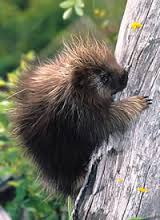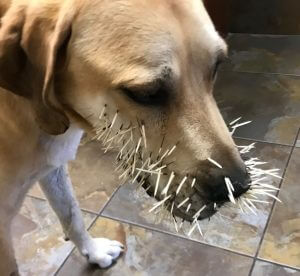We have had a string of quill dogs lately. With the opening of some hunting seasons recently, many dogs are out and about in the woods and run into them incidentally. To a curious dog, a Porcupine can be a strange and interesting creature. They are very slow-moving, which makes them an easy target to catch up with and investigate. Just a close sniff can be trouble and leave the dog with a nose full of quills. If the dog attacks the porcupine, it can end up with a whole face and/or mouth full.
A few things to remember:

- Do not cut the quills off. Contrary to popular belief, it doesn’t make them easier to remove; it actually makes them more difficult.
- It is a myth that porcupines can “shoot” their quills. They can however use their tail as a spiny club and hit predators with it.
- A hemostat is a helpful tool to have in your first aid kit, though needle-nose pliers may also work to remove quills.
- Pull the quills straight out with slow, steady pressure. Yanking them out can cause them to break.
- If quills break off under the skin they will eventually fester out. Watch for infection or draining tracts at the site.
- Removing quills can be painful, be careful not to avoid being bitten. Even the nicest dogs can nip out of fear or pain. A muzzle may be necessary but can be difficult with quills present.
- Most patients require sedation to remove quills. Seek professional help from your veterinarian to have them removed.
Prevention:
Porcupines are mostly nocturnal but can move about in the daytime. We often see them on the move more on rainy days. They are commonly found in trees, chewing on the bark. When walking through forested areas keep a close eye on your dog or better yet keep them on a leash. A well-lit fence can help deter wild animals from frequenting your yard.

What's Next
Call us or schedule an appointment online.
Meet with a doctor for an initial exam.
Put a plan together for your pet.


